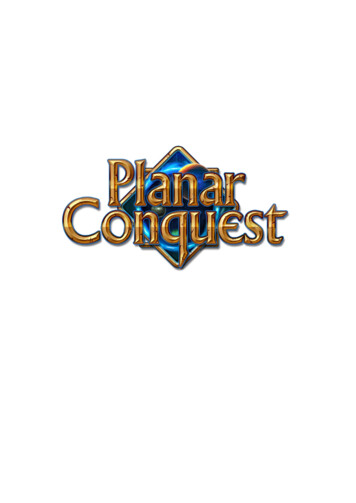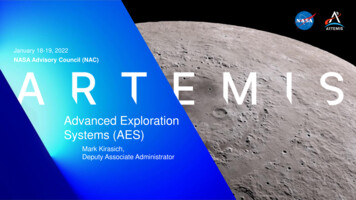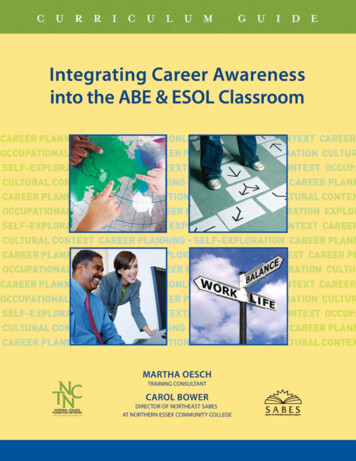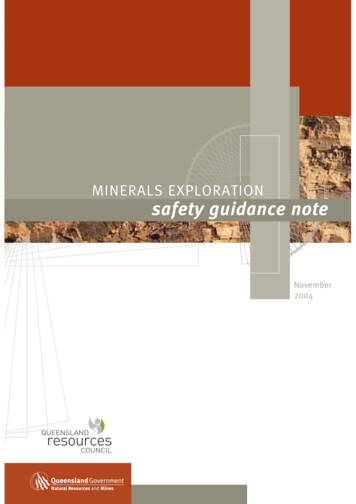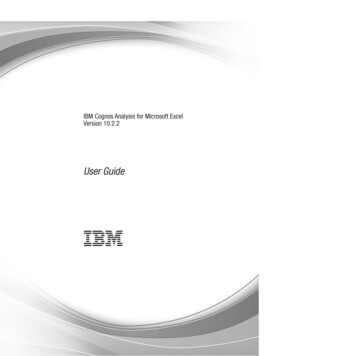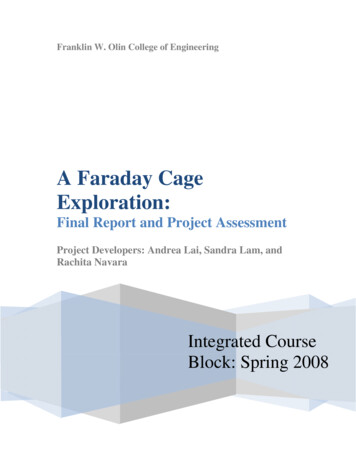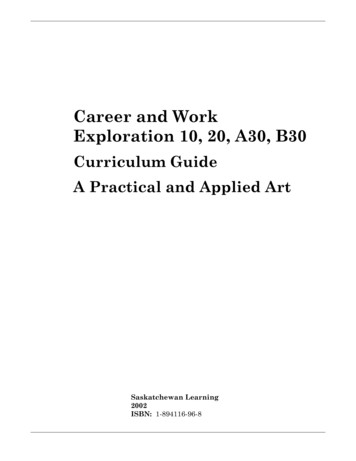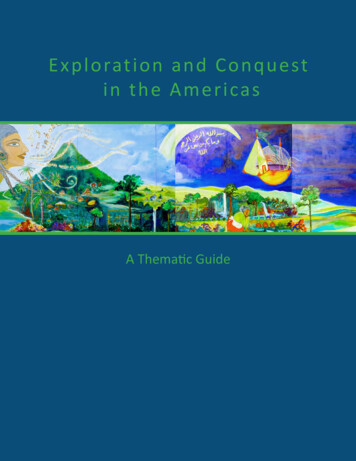
Transcription
Exploration and Conquestin the AmericasA Thematic Guide
INTRODUCTIONThis curriculum was created by the University of New Mexico Latin American & Iberian Instituteas the first of a series of workshops on or related to exploration and the conquistadores, culturalexchange, European and Indigenous encounters, and food. This specific curriculum focuses ondiscussing matters relevant to teaching about Columbus, rethinking how we present Columbus toour students, and providing teaching resources and lesson plans on Christopher Columbus. Thecurriculum provides resources and information that encourage teachers to rethink the traditionalor standard story/history of Columbus, and the ramifications that Columbus’ explorations had onthe Americas.The following unit is divided into three primary curriculum categories: Introductory Activities, Content Activities, and Closure Activities. The content activities have been organized into the followingcategories: Book Studies, Pictorial Input Charts, Reflective Reading and Writing Activities, PrimarySource Activities, Writing Activities, and Music and Art Connections. The unit is designed so that allof the activities can be used in their entirety, or teachers can pick and choose the activities that bestmeet the needs of their curriculum and students. The majority of the activities can be adapted sothat they can be used for all ages. At times a teacher may need to simplify or expand on the contentor the expectations of the activity so that it is relevant for his or her particular grade level. Activitiesthat are specific to a middle or high school have been listed at the end of the curriculum under thatspecific headingThe teacher resource book Rethinking Columbus: The Next 500 Years (2nd ed.) has been the foundation for putting this curriculum project together. The resource book is easily accessible—it can beordered online from multiple sources and often can be found at public and university libraries. Manyof the activities are taken directly from that book or adapted from ideas in the book. When activitiesare taken from the book, we provide specific citation information and draw attention to that page byhighlighting it with a blue bar along the right-hand margin. Due to copyright issues the referencedsections cannot be provided in their entirety; pages numbers are provided to guide teachers to thecorrect section in the resource book. From this point forward, Rethinking Columbus: The Next 500Years (2nd ed.) will be abbreviated as “RTC”. If you decide to use the copyrighted excerpts, pleaserespect the original author’s copyright restrictions.Other activities have been taken from various resources and citations have been provided accordingly. Yet other activities are ideas original to this curriculum, and graphic organizers or other materials have been created to illustrate them. For a complete list of resources used within this guide,please see the Works Cited list found at the end of this document.If you find this material useful, we encourage you to visit the Latin American & Iberian Institute’swebsite (http://laii.unm.edu/outreach) to access the following relevant resources: an electronic copy of this curriculum project; information pertaining to the subsequent workshops offered in this series; and, other Latin American-oriented K-12 teaching resources.
LATIN AMERICAN & IBERIAN INSTITUTEBecause of the geographic location and unique cultural history of New Mexico, the University ofNew Mexico (UNM) has emphasized Latin American Studies since the early 1930s. In 1979, the LatinAmerican & Iberian Institute (LAII) was founded to coordinate Latin American programs on campus.Designated a National Resource Center (NRC) by the U.S. Department of Education, the LAII offersacademic degrees, supports research, provides development opportunities for faculty, and coordinates an outreach program that reaches diverse constituents. In addition to the Latin AmericanStudies (LAS) degrees offered, the LAII supports Latin American studies in departments and professional schools across campus by awarding student fellowships and providing funds for faculty andcurriculum development.The LAII’s mission is to create a stimulating environment for the production and dissemination ofknowledge of Latin America and Iberia at UNM. We believe our goals are best pursued by effortsto build upon the insights of more than one academic discipline. We support research from the humanities and social sciences, as well as the natural sciences, health sciences, and other professionalschools. Therefore when allocating materials and human resources, we give special consideration tobroadly interdisciplinary projects that promote active collaboration from different schools, colleges,and/or departments.The LAII works closely with the K-12 community to help integrate Latin American content materialsinto New Mexico classrooms across grade levels and subject areas. As part of this effort, the LAIIprovides educators with professional development workshops, a database of teacher-designed lesson plans, and related programs.For more comprehensive information about the LAII and its resources for K-12 teaching related tothe Americas, contact:University of New MexicoLatin American & Iberian Institute801 Yale Boulevard NEMSC02 16901 University of New MexicoAlbuquerque, NM 87131Phone: (505) 277-2961Fax: (505) 277-5989Email: laii@unm.eduWeb: http://laii.unm.edu
ACKNOWLEDGMENTSPrimary credit for the creation of this guide is due Katrina Dillon, doctoral student in the Universityof New Mexico’s (UNM) School of Education Department of Language, Literacy, and SocioculturalStudies, and project assistant to the UNM Latin American & Iberian Institute.This guide was made possible with funding from the Latin American & Iberian Institute’s U.S. Department of Education’s Title VI National Resource Center grant.The cover photography, “Mural: Roots and Frequencies Basic to our Education” (1994) is made available courtesy of Franco Folini and is copyrighted under a Creative Commons license. Disseminationof this mural image is made possible courtesy of the original mural artist, Marta Ayala.
Exploration and Conquest in the AmericasTABLE OF CONTENTS234IntroductionLatin American & Iberian InstituteAcknowledgments17INTRODUCTORY 63646568697071Antistereotype Curriculum: All AgesGlad K-W-L Observation and Inquiry Chart Version One: Columbus and Exploration Version Two: Columbus and Exploration“Discovery Activity”“Discovery” Vocabulary InstructionCONTENT ACTIVITIESBook Studies: Morning Girl: A Novel Study Encounter: Read Aloud Picture Book StudyPictorial Input Charts: World Map: Pictorial Input Chart Columbus and a Taíno PersonReflective Reading and Writing Activities: Textbook Detectives Accurate Account of the Columbus/Taíno Encounter Imagining the TaínosPrimary Source Activities: Columbus’ Diary: A Primary Source Bartolomé de las CasasWriting Activities Cooperative Sentence Strip Paragraph on Columbus and the Taíno Dialogue Poem Point of View Journals: Columbus and the TaínoMusic and Art Connections The Song “1492”: Discussion and Analysis of Lyrics Illustrate a Big Book: Christopher Columbus Narrative: Early Years in PortugalLatin American & Iberian Institute5
Exploration and Conquest in the URE ACTIVITIESDebate: Should we Celebrate Columbus Day?Topic of DebateBig BookTrialMIDDLE AND HIGH SCHOOL ACTIVITIESTimeline: “Spain, Columbus, and the Taínos”“Open Your Hearts”: A Dominican Friar Speaks OutCeremony: A PoemColumbus Day: A PoemCURRICULUM STANDARDSNM Language Arts Standards and BenchmarksNM Social Studies Standards and BenchmarksRESOURCESWorks CitedEvaluationSupplementary DocumentsLatin American & Iberian Institute6
Exploration and Conquest in the AmericasINTRODUCTORY ACTIVITIESThere are multiple ways to begin this unit depending upon how you want to contextualize it andhow much time you have. In the curriculum guide Rethinking Columbus (RTC), Bob Petersonsuggests beginning this unit with a series of Anti-Stereotype Curriculum activities. For more indepth discussion of this, see RTC pp. 36-38. You could also begin with a modified version of aK-W-L as taken from Guided Language Acquisition Design (GLAD) strategies. Another possibilityis to begin with the “Discovery” Activity discussed in RTC, p. 17. The following is a brief description of these introductory activities You can choose to do one, two or all three, depending on yourpreference and time. The purpose for all of these is to focus, motivate, and engage students whileactivating prior knowledge and providing you with an informal assessment of students’ familiaritywith the subject.Latin American & Iberian Institute7
Rethinking Columbus. “Anti-Sterotype Curriculum” (pp. 35-41)Exploration and Conquest in the AmericasAnti-Stereotype Curriculum: All AgesThis activity comes directly from Bob Peterson’s article “Columbus and Native Issues in the Elementary Classroom” in RTC, pp. 35-41. The following is an extended direct citation (RTC, pp. 36-38) fromthe RTC article, with the exception of the italicized notes which have been added as elaborations.The article in its entirety is a great resource, and highly recommended.Process1. Show the DVD “Unlearning “Indian” Stereotypes”. This is approximately 12 minutes and comeswith a teacher’s guide. It was originally produced by the Council on Interracial Books for Children, 1977, as a film strip. It was re-released as a DVD in 2008. The cost for the DVD and Teacher’s Guide is 19.95 from Rethinking Schools website.2. Ask students if they know any “Indian” person and what that person is like. Note: This part isup to the discretion of the teacher. The purpose is for students to vocalize stereotypes that theymay have, but don’t realize are stereotypes (yet). It may also serve to show that many studentsthink “Indian” is synonymous with the past, or cartoons, as they won’t be able to share about aperson they know. In schools/classrooms where there is a Native population and there are Native students in the class, this activity may need to be re-framed or omitted depending upon howstudents may react to this.3. Explain the word “stereotype” as a mistaken idea about how a whole group of people think, behave, or dress. Give an example that does not relate to American Indians, such as the view bysome that girls can’t be good baseball players, or boys can’t cook.4. Explain what’s wrong with stereotypes—that they are not only factually wrong, but that they’rehurtful. Talk with students about why they are harmful. Give examples such as a coach havinga stereotype about girls: that they can’t play baseball well. That could easily lead to the coachdiscriminating against and not letting them be on the team. It can also prevent girls from havingthe opportunity to play and practice, making the stereotype self-fulfilling.5. Concretely explain some stereotypes, and try to make analogies with children’s own experiences. For example, explain that some native nations used feathers for ceremonial purposes,but that many others did not. Ask the children how their family dresses for special occasions andceremonies, such as weddings. Point out that it’s a stereotype to think that all people of theirethnic background always dress as if they were at a wedding. Likewise, it’s a stereotype to thinkthat all Indians dress with feathers all the time.6. As part of a class discussion, list common stereotypes about Native Americans. Have childrenidentify the stereotypes as they are used in Thanksgiving greeting cards, alphabet and countingbooks, history books, or children’s books on Columbus. In RTC p. 36 Peterson provides a stereotype checklist that can be used as a guide for a list your class could create.7. Explain how these stereotypes are used to make Indians seem inferior or less than human.Don’t limit your critiques to textbooks. Some of the most common stereotypes are in alphabetbooks that have “I for Indian” or in children’s favorites such as “Clifford’s Halloween” by NormalBridwell in which Clifford uses a feather head dress to dress up as in Indian; or Maurice Sendak’s “Alligators All Around,” in which the alligators are “imitating Indians” by wearing featherheaddresses, carrying tomahawks, and smoking pipes. Also look at the stereotypes in societyat large, such as in the names of sports teams or cars or mascots for schools. Talk about theCleveland Indians, or the Jeep Cherokee, or Winnebago motor homes. Ask if the children knowLatin American & Iberian Institute8
Rethinking Columbus. “Anti-Sterotype Curriculum” (pp. 35-41)Exploration and Conquest in the Americasother cars or sports teams named after nationality groups. If not, why are Indians singled out?Have students reflect on how such stereotypes hurt Indians and distort other people’s images ofthem and their rich cultures.8. Use the article “Human Beings Are Not Mascots” (from RTC, p. 131) about people fighting againstIndian “mascots” to start a discussion on what people can do to fight stereotypes.9. In books that children bring to class, whether from home or library, consistently point out anddiscuss any stereotypes. As we model such thinking and give children the opportunity to thinkon their own—“Did you notice any stereotypes in that story?”—children will improve their ability to think critically.10. Videotape a Columbus or Thanksgiving special from TV or choose most any Thanksgiving or Columbus filmstrip or videotape from a school curriculum collection. Watch it with your studentsand critique it together.11. Have students make posters about common stereotypes of various groups of people. Have thechildren explain how the stereotypes hurt people. I have found that as children start learningabout stereotypes, they often generalize and think everything is a stereotype: that all picturesof native people in traditional dress or any picture of a woman as a nurse are stereotypes. Oneway to deal with this is to get children to teach others about stereotypes—by explaining theirposters, doing short presentations or skits.12. Use quality books to show how contemporary native people live and look.13. Invite Native American adults into your classroom to talk about their jobs and family and howthey feel about how Native Americans have been treated.14. Have children think about a time in their lives when they fought against something that wasn’tfair. Explain how native peoples have fought for what is “fair”—their land and way of life.Latin American & Iberian Institute9
Exploration and Conquest in the AmericasGLAD K-W-L Observation and Inquiry ChartThe following two activities are designed for all ages.Version One: Columbus and ExplorationPreparationGoogle images related to your unit on Columbus and/or exploration. Print off various images thatare the most thought provoking and interesting. You only need one copy of each image. Glueeach image to a large piece of paper—construction paper glued together vertically or long strips ofbutcher paper. You will divide your class into small groups and provide each group with a copy of animage. An example image of the completed exercise is included on the following page.Process1. Explain to students that they are going to be working in small groups. Each group will rotatearound the room to each table. One person will need to be the secretary at each table—they cantake turns doing this job. At each table there will be an image. As a group they will look at theimage and discuss the questions “What do you see?” “What do you think is happening?” “Howdoes this picture make you feel?” Then, the secretary will record their answers to the question. You could also put a pad of sticky notes at each table and have students record their ownthoughts and stick them on the paper when they’re done, instead of having a secretary. Be sureto explain to students that they will have a set amount of time at each picture—usually about 5minutes, but to be determined by the teacher. Explain that you will give students a signal at theend of each 5 minutes and students will rotate to the next image at the next table, until theyhave rotated through all of the images.2. Place one image glued onto paper at each table group with one marker (and sticky notes if youare using them). Begin the activity, rotating students through each image at 5-minute increments.3. Hang up or post all of the images with comments. Discuss each image, giving students time toshare and respond to what they posted. Keep these posted throughout the unit, allowing students to revisit them, or discuss them as they learn more about the unit and possibly the images.Latin American & Iberian Institute10
Exploration and Conquest in the AmericasLatin American & Iberian Institute11
Exploration and Conquest in the AmericasVersion Two: Columbus and ExplorationPreparationGoogle images related to your unit on Columbus and/or exploration. Print off the TWO that are themost thought provoking and interesting. You only need one copy of each image. Glue each imageto a large piece of paper—butcher paper or large poster board work best. Underneath one imagewrite the question: What do you know about Christopher Columbus? (or exploration, explorers,etc—whatever relates most closely to your unit). Underneath the other image write the question:What do you want to know about Christopher Columbus? (or whatever your focus is).Process1. Hang the images on the board so that all students can see them. Read the questions out loudand make sure that students understand them. Then give each student a few sticky notes andask them to answer each question—If possible color code the notes—one color for what youknow, another color for what you’d like to know. As students finish, have them stick their questions to the appropriate paper.2. When all students are done, read their comments out loud and discuss them. As their commentsare addressed throughout the unit, refer back to the two charts.3. Keep these posted in the room throughout the unit. At the end of the unit, you can go back totheir comments on “What do you want to know about ?” as one meansof review and closure.Latin American & Iberian Institute12
Rethinking Columbus. “Discovering Columbus: Re-reading the Past” (pp. 17-21)Exploration and Conquest in the Americas“Discovery” ActivityThis activity, designed for all ages, is taken from Bigelow’s article “Discovering Columbus: Re-readingthe Past” in RTC (pp. 17-21). See the article for a more detailed discussion of activity.PreparationAsk a student ahead of time if you can use his backpack, purse, desk, etc. for a demonstration. Besure to let him know that he must keep it a secret for it to work.ProcessAt the beginning of class, ‘steal’ the student’s purse, backpack etc. Announce that it is yours because you have it, you found it. A few, if not all, of the students will protest, saying they saw youtake it. Reiterate that it is yours, you have it in your hands, that makes it yours. Begin going throughthe things pointing out that all of these items are yours. Some students will likely continue to protestthat it is not yours. Ask them “How do you know that this isn’t mine?” Continue with questions like:“If we had a test on the contents of the purse, who would do better, student or I?” “Whose laborearned the money that bought the things in the purse, mine or student?” These are obvious questions with obvious answers.Ask one last question: “What if I said I discovered this purse, then would it be mine?” Students willlikely respond no, so follow up with “So, why do we say that Columbus discovered America?” Thisactivity could continue into a discussion of how to define “discovery” or a more explicit means ofvocabulary instruction. For a more discussion-based lesson, (probably more appropriate for upperelementary grades) as a class create a definition that works for everyone and keep it posted in theroom. Use the following questions to guide the discussion: Does discovery mean to find? If youdiscover something, does it mean that no one else has ever found/seen it? Or does it mean that it isnew to you? Is there any relationship between discovery and ownership?You could also segue way to a more systematic form of vocabulary instruction. The following isbased upon a vocabulary instruction strategy used in Guided Language Acquisition Development(GLAD). It could be used here, or any other time that fits appropriately with your unit. It can beused with the word “discovery” and for any other word that is central to your unit. Pictures havebeen provided to offer a visual of what is being described for those not familiar with GLAD instruction. For more information about GLAD instruction and strategies, visit the Project G.L.A.D. website:http://www.projectglad.com/.Latin American & Iberian Institute13
Exploration and Conquest in the Americas“Discovery” Vocabulary InstructionPreparationCreate a large table—butcher paper works best. It will have as many rows as you have words (oras many rows as you can fit on your paper) and 4 or 5 columns depending upon whether you usethe last one. The titles of the columns are: WORD, PREDICTION, FINAL MEANING, ORAL SENTENCE,and possibly PICTURE OR CLUES. The picture on the following page illustrates this activity. Someteachers also include a column for the Spanish (or other language) word, which can be especiallyuseful in a multi-lingual classroom. Write the word “discovery” in the first column of the first row.Underneath “discovery” (same row, same column) ,write an H and NH. The chart is typically colorcoded by column.Here, you’ve already introduced students to the word “discovery,” but they haven’t really discussedwhat they think it means, so you want to start there.Process: Day One1. Pre-assessment: Ask students to raise their hand if they’ve heard the word discovery before today. Count the number of students who have heard the word and write this number next to theH. Ask students to raise their hand if they’ve never heard the word discovery. Count the numberof students and write this number next to NH. This serves as an informal assessment tool for youto gauge students’ familiarity with this word.2. Predictions: Instruct students to turn to their tablemates, small group, or a partner and comeup with their prediction for the definition of the word discovery—what they think it means. Ifstudents are unfamiliar with the word prediction, be sure to discuss that first. Give students oneminute to discuss.3. Give a predetermined silent signal for students to come back to whole group and ask studentsto take turns sharing their predictions. You can use this as an opportunity for language fluency,encouraging them to create complete sentences that start with “We predict discovery means.”As students share, write their predictions on the chart.4. Signal Movement: The next step is to create a signal movement that ‘shows’ the word. You canteach the students one that you have in mind, or ask them for help in creating it and see whatthey come up with. Once students know the movement, they practice doing the movementwhile saying the word. If you want students to create the move, but don’t think they have astrong enough understanding of the word, you can postpone the signal movement until afterthe “Final Meaning” on Day Two. If adhering to GLAD strategy, your vocabulary instruction forthe day would stop there. The following day you would introduce the Final Meaning, and do theintroduction, prediction, and movement for the next word. How you do this is up to you.5. Final Meaning Day Two: Write the final meaning of the word on the chart under the appropriatecolumn. Read the definition out loud and discuss it in comparison to their predictions. Give acouple of examples of how one could use this word in the sentence. This is also a good opportunity to discuss parts of speech—writing noun, verb, adjective, adverb, etc. underneath the wordyou are discussing.6. Oral Sentence: Give students one minute to come up with a sentence using the word correctlyand share that sentence with a table partner. After one minute, signal for students to come backto whole group, and have each student share his/her sentence. Correct the student if necessaryand help them to fix the sentence and say it again.Latin American & Iberian Institute14
Exploration and Conquest in the Americas7. Then, you would introduce the next new word, starting the process all over again.8. Review: Each day review the words from the chart, practicing the signal movement, and lettinga few students offer a sample sentence.Below is an example image of the completed exercise.Latin American & Iberian Institute15
Exploration and Conquest in the AmericasCONTENT ACTIVITIESThe following activities are to be used after the unit has been introduced to students. There are arange of activities presented, with some more appropriate for certain age groups than others. Thefollowing activities have been created so that teachers can pick and choose the activities that meettheir needs and time constraints, as many classrooms may not have the time to complete all ofthem. Many of the activities are taken directly from other curriculums or teacher resource guidesand are cited to give the respective authors their credit. Others are activities that have been created as extensions that build upon these cited resources and curriculum guides, and then some areoriginal to this curriculum project. The following activities have been organized by the followingsubheadings: Book Studies, Pictorial Input Charts, Reflective Reading and Writing Activities, PrimarySource Activities, Writing Activities, and Music and Art Connections.These activities can stand on their own as a unit, or they can be used in combination with a SocialStudies/History text book curriculum that focuses on explorers or Christopher Columbus.Latin American & Iberian Institute16
Exploration and Conquest in the AmericasCONTENT ACTIVITIES:BOOK STUDIESLatin American & Iberian Institute17
Exploration and Conquest in the AmericasMorning Girl: A Novel StudyThis activity is based upon the following book:Dorris, Michael. (1992). Morning Girl. New York: Hyperion.ISBN-10: 078681358X; ISBN-13: 978-0786813582Morning Girl is a novel that can be used in a variety of ways. It can be used as a Read Aloud novelstudy, small group guided reading, or a class guided reading novel if you have enough copies of thebook. This activity doesn’t necessarily need to be the first activity that you do, but as a guidedreading activity it is better to start it early on in the unit. If you do, try to read a little each day sothat your students absorb the information from the novel sooner rather than later. It is a short book(only 74 pages), so it could easily be read in a week or two depending upon how much time youdevote to the activities and guided reading questions.The book is divided into nine chapters. The chapters alternate between the sister’s point of viewand the brother’s point of view. Because of this, it makes the most sense to read two chapters inone sitting.Below I’ve included Character Map Activities, Guided Reading Questions and Writing Activities thatcan be used to accompany the book. The Writing Activities are interspersed within the Guided Reading Questions because they are connected to specific chapters of the story.Activity One: Character MapOne possible ongoing activity is to have your students create character maps of the two main characters: Morning Girl and Star Boy. These could be started after the first two chapters, then added tothroughout the rest of the story. When the class has finished the entire story and completed theircharacter maps, the activity could be extended further. Using their character maps, students can fillout a Venn diagram comparing and contrasting Morning Girl and Star Boy. If you would like to extend it further, students can use their Venn diagram to write a two paragraph compare and contrastessay about the two characters. Depending upon the grade level of your students, you may need toprovide a template or model sentences to guide students in how to write appropriately structuredparagraphs for a compare and contrast essay. Another option is to do the character maps, Venn diagram, and compare and contrast essay as a whole class. This could be especially helpful if studentsare new to any of these activities. This would provide the opportunity to model these activities using a read aloud book.The link below connects to a more interactive character map that students can fill out online—cutting and pasting images, shading shapes depending upon what they relate to, etc. It is a great way toteach character mapping and computer skills, but obviously requires access to computers. It couldbe used as a small group activity that students rotate through if you have classroom computers. Forthose teachers who have RtI (Response to Intervention) blocks, this could also be an activity appropriate for that time—it could be used as either a remedial or enrichment activity depending uponthe grade level of your students and the expectations you set for the assignment. It could also be offered as an extra credit activity if your students have access to computers outside of the /teachers/plans/Pages/character-mapping.aspxLatin American & Iberian Institute18
Exploration and Conquest in the AmericasActivity Two: Guided Reading QuestionsThe following questions can be used in multiple ways, in part depending upon how you are using thebook. They can be cut and pasted into a sheet of questions that students fill out; they can be usedas oral comprehension questions that you ask students to assess and guide their comprehension; orthey can be used to create a comprehe
ences. For example, explain that some native nations used feathers for ceremonial purposes, but that many others did not. Ask the children how their family dresses for special occasions and ceremonies, such as weddings. Point out that it’s a stereotype to think that all people of their eth
